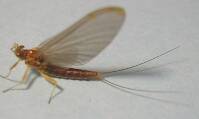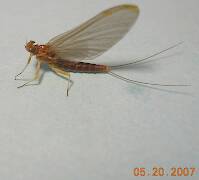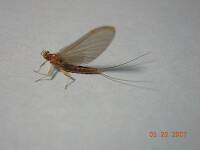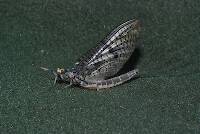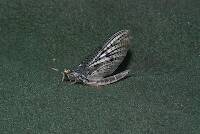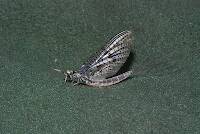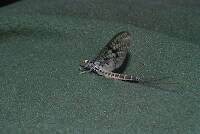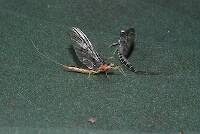
Hex Mayflies
Hexagenia limbata
The famous nocturnal Hex hatch of the Midwest (and a few other lucky locations) stirs to the surface mythically large brown trout that only touch streamers for the rest of the year.
Featured on the forum

As far as I can tell, this species has only previously been reported from one site in Oregon along the Columbia gorge. However, the key characteristics are fairly unmistakable in all except for one minor detail:
— 4 small yellow spots on frons visible in photos
— Narrow occipital spinule row curves forward (but doesn’t quite meet on stem of ecdysial suture, as it's supposed to in this species)
— Short spinules on anterior margin of front legs
— Short rposterior row of blunt spinules on abdominal tergae, rather than elongated spinules dorsally
I caught several of these mature nymphs in the fishless, tiny headwaters of a creek high in the Wenatchee Mountains.
— 4 small yellow spots on frons visible in photos
— Narrow occipital spinule row curves forward (but doesn’t quite meet on stem of ecdysial suture, as it's supposed to in this species)
— Short spinules on anterior margin of front legs
— Short rposterior row of blunt spinules on abdominal tergae, rather than elongated spinules dorsally
I caught several of these mature nymphs in the fishless, tiny headwaters of a creek high in the Wenatchee Mountains.

Troutnut is a project started in 2003 by salmonid ecologist Jason "Troutnut" Neuswanger to help anglers and
fly tyers unabashedly embrace the entomological side of the sport. Learn more about Troutnut or
support the project for an enhanced experience here.
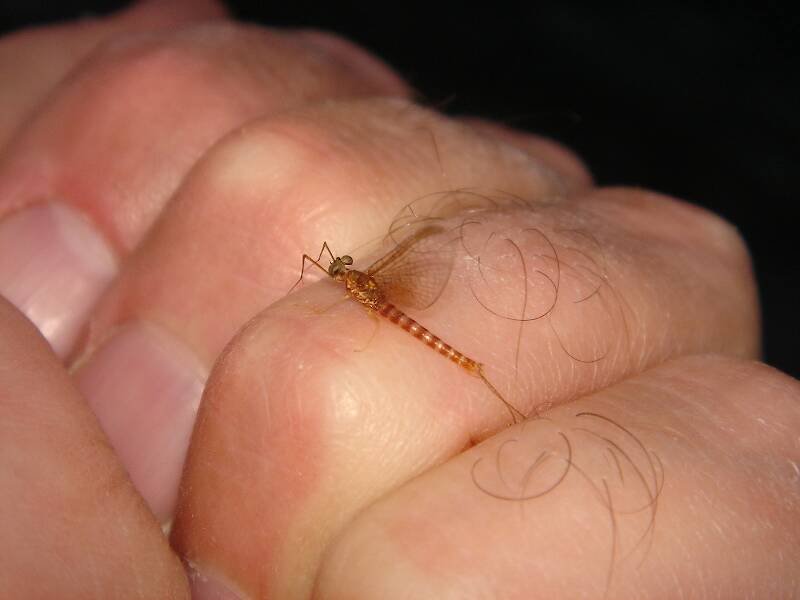
Levwood on Jul 20, 2008July 20th, 2008, 1:35 pm EDT
Could you please help me identify the bug in the attached photo. I
> was fishing last week in SW Alberta on the Crowsnest River. These
> spinners came out at around 9:00 and we fished to them for about an hour.
>
> Vic Bergman at the Crowsnest Angler says it is a Quill Gordon. I
> looked at some of your photos and descriptions. Could it be /Epeorus/
> /
> albertae/ ? I'd say it's a size 16.
>
> Please give it a shot and let me know.
>
> Thanks,
>
> Lev
> was fishing last week in SW Alberta on the Crowsnest River. These
> spinners came out at around 9:00 and we fished to them for about an hour.
>
> Vic Bergman at the Crowsnest Angler says it is a Quill Gordon. I
> looked at some of your photos and descriptions. Could it be /Epeorus/
> /
> albertae/ ? I'd say it's a size 16.
>
> Please give it a shot and let me know.
>
> Thanks,
>
> Lev
Lev
GONZO on Jul 20, 2008July 20th, 2008, 3:32 pm EDT
Looks about right for an E. albertae spinner, though I suppose it could be longimanus. The folks on the Crowsnest apparently refer to the Epeorus hatches generally as Quill Gordons, even though they are not E. pleuralis.
Amosg
Posts: 5
Posts: 5
Amosg on Aug 28, 2011August 28th, 2011, 12:17 pm EDT
Gonzo--correct--I live just north of the 'Crow" and the locals in the pass call them Quill Gordons and don't do no Latin. Your latter two educated guesses are good ones.
GONZO on Aug 28, 2011August 28th, 2011, 1:08 pm EDT
Your latter two educated guesses are good ones.
Thanks, but the "education" of those guesses is questionable. I no longer think that this is Epeorus.
Taxon on Aug 28, 2011August 28th, 2011, 2:05 pm EDT
Okay Lloyd, I'll bite. So, what think you now? :-)
GONZO on Aug 28, 2011August 28th, 2011, 4:20 pm EDT
Methinks it's not Epeorus, Roger. (I'll reserve my hunch about what it is for now.)
If this male spinner was Epeorus, the eyes should be larger and contiguous or nearly so. If it was E. albertae, typical specimens would have a dark marks (maculae) at the centers of the femora and a brownish band at the ends, the humeral veins of the forewings would be black, the terga would have narrow dark bands at the posterior margins, and there should be black stripes on the thoracic pleurae. If it was E. longimanus, typical specimens would have distinct dark maculae on the femora and there would be a black diagonal streak at the forward corner of each abdominal segment. Neither species should have the amber suffusion in the lower half of the forewings.
If this male spinner was Epeorus, the eyes should be larger and contiguous or nearly so. If it was E. albertae, typical specimens would have a dark marks (maculae) at the centers of the femora and a brownish band at the ends, the humeral veins of the forewings would be black, the terga would have narrow dark bands at the posterior margins, and there should be black stripes on the thoracic pleurae. If it was E. longimanus, typical specimens would have distinct dark maculae on the femora and there would be a black diagonal streak at the forward corner of each abdominal segment. Neither species should have the amber suffusion in the lower half of the forewings.
Entoman on Aug 28, 2011August 28th, 2011, 5:29 pm EDT
Lloyd -
Ha! Ditto...:)
I can say that learning from you that certain families can have bi-colored leg sets has alleviated a big issue for me though. Sure would be nice to have a better view of the tarsi, eyes and wings. This is one of those unlucky photos that seems to have every area that could be used for an easy determination blurred out.
Be that as it may, as far as western Epeorus go, this critter isn't even in the same ball park. Besides the features you mentioned, there's just way too much pigment in the veins, especially the cross veins which in longimanus and albertae are clear enough that we probably shouldn't be able to make them out in this photo. The mid and hind legs are way too feeble and the body conformation is all wrong. Unless the model in the photo has very small hands, this specimen looks to be over 15 mm. I could go on, but I think we've made the point.
Regards,
Kurt
Methinks it's not Epeorus, Roger. (I'll reserve my hunch about what it is for now.)
Ha! Ditto...:)
I can say that learning from you that certain families can have bi-colored leg sets has alleviated a big issue for me though. Sure would be nice to have a better view of the tarsi, eyes and wings. This is one of those unlucky photos that seems to have every area that could be used for an easy determination blurred out.
Be that as it may, as far as western Epeorus go, this critter isn't even in the same ball park. Besides the features you mentioned, there's just way too much pigment in the veins, especially the cross veins which in longimanus and albertae are clear enough that we probably shouldn't be able to make them out in this photo. The mid and hind legs are way too feeble and the body conformation is all wrong. Unless the model in the photo has very small hands, this specimen looks to be over 15 mm. I could go on, but I think we've made the point.
Regards,
Kurt
"It's not that I find fishing so important, it's just that I find all other endeavors of Man equally unimportant... And not nearly as much fun!" Robert Traver, Anatomy of a Fisherman
Cutbow on Aug 28, 2011August 28th, 2011, 8:24 pm EDT
I think it's a segmented rusty spinner that trout eat! :) But seriously I could only echo the above statements. I have no idea what it is beyond how to imitate it. I will say the eyes could very well be dark given a possible illusion created by a black background behind the hand and bright flash. How many mayflies to we photograph in the dark? Was the photo taken in the dark?
"Once you catch your first fish on a fly you won't care about any other kind of fishing!"
Taxon on Aug 28, 2011August 28th, 2011, 9:08 pm EDT
Lloyd and Kurt-
This thread seemed to jog my memory, so I went back and reviewed my emails from several years ago, and sure enough, for better or worse, I seem to be on record with this one, so I'll share what I thought at the time. :-)
This thread seemed to jog my memory, so I went back and reviewed my emails from several years ago, and sure enough, for better or worse, I seem to be on record with this one, so I'll share what I thought at the time. :-)
-----Original Message-----
From: FlyFishing Entomology [mailto:FlyfishingEntomology@comcast.net]
Sent: Saturday, March 28, 2009 7:11 PM
To: levwood@*********
Subject: RE: What is this bug?
Hi Lev,
... The bug in your attached photo is a male mayfly spinner, and I believe it to be Cinygmula, perhaps C. reticulata.
Best regards,
Roger Rohrbeck
Sayfu
Posts: 560
Posts: 560
Sayfu on Aug 29, 2011August 29th, 2011, 9:34 am EDT
Wish I could participate, but do not have the level of bug knowledge that many of you have. I have been tying up, and matching the E Albertae hatch right now, and will be on the SF of the Snake tomorrow matching the hatch. We call them Pink Alberts sometimes called Pale Evening Duns...size #12-14 fast water emergers, light, pale bodied, and best results are tied using pale pink bodies. I see the spinners over the water, but never have gotten a look at them..no interest, other than good to see them I guess. The hatch is never big, but fish sure go for the duns.
Entoman on Aug 29, 2011August 29th, 2011, 5:08 pm EDT
Roger -
Ah, perhaps you're right. It's a much better fit than Epeorus, though most Cinygmula male spinners I've seen have pretty transparent middle abdominal segments. I guess I'm having problems with thinking it's any heptageniid at this point, primarily over the legs.
Hi John -
Welcome to the forum! Yeah, the photo looks to have been taken with a flash which will make dusk conditions look pitch black. It is astute of you to mention the effect that time of day has on eye color. Eyes can look entirely different in bright light as apposed to the darkness of evening.
Regards,
Kurt
Ah, perhaps you're right. It's a much better fit than Epeorus, though most Cinygmula male spinners I've seen have pretty transparent middle abdominal segments. I guess I'm having problems with thinking it's any heptageniid at this point, primarily over the legs.
Hi John -
Welcome to the forum! Yeah, the photo looks to have been taken with a flash which will make dusk conditions look pitch black. It is astute of you to mention the effect that time of day has on eye color. Eyes can look entirely different in bright light as apposed to the darkness of evening.
Regards,
Kurt
"It's not that I find fishing so important, it's just that I find all other endeavors of Man equally unimportant... And not nearly as much fun!" Robert Traver, Anatomy of a Fisherman
Quick Reply
Related Discussions
Topic
Replies
Last Reply
0
May 3, 2007
by Troutnut
by Troutnut
Re: Last summer while fishing on the Henry's Fork in Idaho.....Is it Epeorus Pleuralis???
In the Identify This! Board by Byhaugh
In the Identify This! Board by Byhaugh
10
Jan 16, 2014
by Entoman
by Entoman
4
Dec 22, 2009
by Oldredbarn
by Oldredbarn





